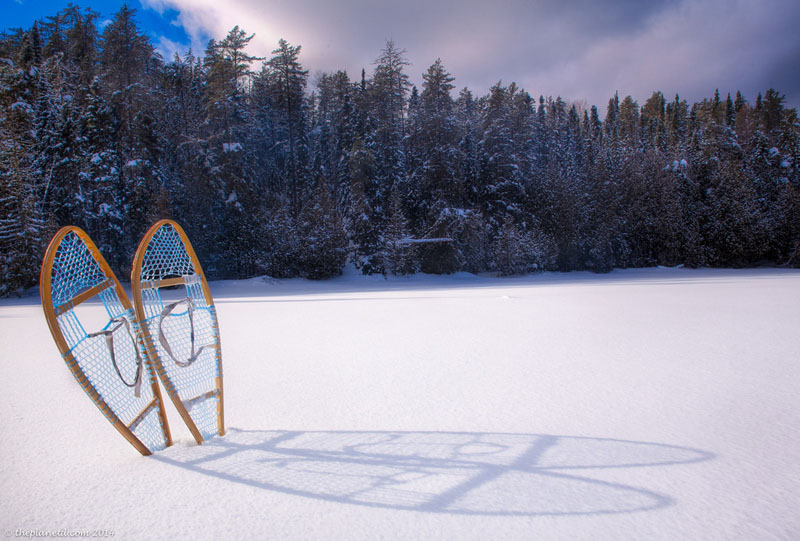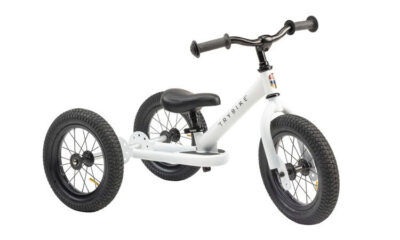Guides & Tips
8 Tips for Safe and Comfortable Winter Trekking

Winter adventure is fun, but it can be dangerous. Here are tips for safe and comfortable winter trekking to make the most of your adventure.
Winter Trekking Tips
Winter is cold but that doesn’t mean it can’t be comfortable.
You just need to stock up on the right gear and arm yourself with a little knowledge to stay safe and comfortable when winter trekking.
Here are our tips to help you winter trek more efficiently while staying comfortable and warm!
Layering Tips

People who don’t know a lot about cold weather think you have to stay bundled up at all times, but if you are warm, you can strip down.
It’s important to not let yourself overheat.
When working out in the cold, we strip right down to our bare minimum layers to keep from having sweat build up. You want to have as little moisture on your body as possible.
When you do stop activities, put your layers back quickly.
A down jacket or parka can be strapped on to the outside of your sled so you can put it on whenever you stop to stay warm.
We even had two different weighted hats. A light wool hat for trekking and a heavy hat for rests and easy walking. I loved my cozy aviator hat that I put on whenever we stopped. It felt so good to get my head warm.
Hot Tip: The easiest way to cool yourself down quickly when trekking is to take off your hat.
Base Layer

Merino Wool layers – tops and bottoms. Icebreaker is the brand we like and you can buy it at SportCheck.
It’s expensive, but you will have it for years. It wicks away moisture and it is odor resistant. On Lure of the North, we only wore two sets of our merino wool base layers (wool usually makes me itchy, but not this stuff) and they worked like a charm.
They stayed warm and didn’t smell!
While trekking, we took off all our layers except our base layer. This way we didn’t sweat.
When we stopped or were doing easy walking, we put our layers on. The great thing about wool though is that even if it gets damp, it still keeps you warm.
Mid Layers

Fleece or wool sweater: We had a fleece mid-layer and a very lightweight down mid-layer (the Canada Goose Hybridge is our new favorite piece of gear).
We alternated between these two mid-layers depending on the temperature.
Fleece pants or insulated snow pants – For bottoms, we had insulated, waterproof snow pants that could be unzipped for venting. For this trek, we ended up taking out our fleece mid-layer pants.
We were happy with this decision for this trek, but in warmer temperatures, I would keep the mid-layer with a mix of an outer bottom waterproof shell.
We kept our waterproof Gortex pants with us though we ended up not using them as our insulated pants did the trick.
If working hard in windy or rainy weather, make sure to have an outer Gortex layer. Our trekking guides Kielyn and Dave swear by traditional Anoraks as an alternative to expensive Gortex jackets.
Outer Layer and Warm Coat

We then had a windproof jacket for the windy or wet days.
So be sure to have a breathable outer layer. Even though it is cold outside, you need to be able to have material that will breathe.
When we stopped to rest for a while, we have parkas to change into to keep warm.
A good puffy down jacket with a high weight count is also a good option.
Face Coverings

No matter how hot you get when hiking, your face still freezes.
I especially keep my face covered as much as possible because I hate the feeling of a cold neck and chin.
I used a breathable face mask for really cold days and several buffs for my head and neck that I interchanged regularly.
Also, make sure to have a good pair of sunglasses and goggles for snowy and windy weather.
- (Bring a back-up pair of sunglasses if you can – one of our expedition mates Leslie broke her sunglasses on the trip) Luckily she had an alternative with her.
Hats
When trekking, we wear a lightweight base layer hat. You want to keep heat in, but if you overheat, it can cause a chill.
So we interchange a light hat for trekking and then we put on a heavier lined wool hat or aviator hat for when we are at rest.
When winter trekking, we carry three different weights of hats for different weather and temperatures.
Use the right winter gear

When doing winter trekking, know your task. No one piece of gear fits all expeditions.
For example, there are times when the modern snowshoes are better and there are times when traditional is better. So think about that before you rent or buy any of your gear.
Snowshoes

When trekking in the winter, a lot of people think that “modern” means better.
But while talking to all the experts, we’ve learned that if you are going on a full-on winter trek into the backcountry, you should use traditional snowshoes.
Traditional Snowshoes vs Sport Snowshoes
The small sportier snowshoes that you buy at MEC are great for trails or high mountain trekking with little snow, but for a serious northern winter trek, traditional snowshoes were a perfect choice.
They are larger and you sink in less than you would on the smaller snowshoes. We had two pairs of snowshoes, large Hurons for long distances and for portaging and camp life, we wore smaller bear paw snowshoes.
However, depending on the trek, you will require different gear.
If you are high altitude or glacier trekking you will need crampons and solid hiking boots, if you go farther north, you will want to have cross-country skis as they are more efficient.
Our advice is to make sure you know what gear you need for what situation. Do your research.
Tents

When we went winter camping in Antarctica we froze.
We slept in bivy sacs on the continent and counted the hours until we could get back to warmth.
When camping traditionally, you are quite comfortable. You carry more gear with you on sleds, but it all helps you sleep comfortably.
A canvas tent is cozy and warm compared to the modern nylon tents.
A wood stove can be safely set up inside and a fire can be lit all night long.
However, this form of camping won’t work if you are in Antarctica or farther into the Arctic Circle as there aren’t any trees.
That is when the modern tents work well with camp stoves. So once again, know where you are going and what resources are available to you.
Hot tip: When winter trekking use a foam thermarest as opposed to an inflatable one. Pine needles will puncture your mattress making sleeping very uncomfortable
Sled

When winter camping in Northern Ontario, it pays to pull a sled loaded up with all your gear as opposed to carrying it on your back.
Lure of the North makes and sells polycarbonate sleds that are very durable and flexible.
You can pull your gear easily over frozen rivers and through portages over fallen trees, up and down hills, and over rocks.
Boxes, bags, wood stove, tent… everything can be strapped on with ratchet straps and bungee cords.
However, if you are in the mountains, a backpack will work better. So once again, make sure you match your gear to the type of trek you are doing.
Safety

It’s important to know what you are doing before you go out to the backcountry or to hire a guide like we did.
You need to take the thin ice and moving water into consideration and you should never walk on ice unless you are sure that it is safe.
This is where hiring a professional is the best option.
Use a SPOT Locator
We checked in via GPS every night to let people know that we were alive and well.
A SPOT locator will alert the friends or family you have monitoring at home that you are safe and if they don’t hear from you, they can alert emergency dispatch about your radio silence.
It will give off a signal and they can rescue you via your GPS coordinates.
It’s important to never go out without letting someone know your route and your schedule. We even used the Track 24 Iridium tracking for the Mongol Rally. It’s good for all trekking.
Ice Safety

Ice is the biggest risk when winter trekking in Northern Ontario.
We are blessed with a lot of pristine waterways in Canada, and if you are trekking long distances, chances are you will be trekking over frozen lakes, rivers, or creeks.
If you do find yourself on a frozen lake or river, here are some tips to navigate across safely.
Tips for Ice Safety
I’ll say it once and I’ll say it again, hire a guide.
Don’t go out on a lake if you don’t know what you are doing.
When going to remote destinations, you won’t be able to check with the locals to see if the lakes are solid. You will need to rely on your skills.
Here is how Dave and Kielyn checked for thin ice.
How to Check for Thin Ice

Lakes are more likely to be frozen than rivers. Surprisingly it is safer out in the middle of
-

 Destination9 months ago
Destination9 months agoSingapore Airlines CEO set to join board of Air India, BA News, BA
-

 Breaking News10 months ago
Breaking News10 months agoCroatia to reintroduce compulsory military draft as regional tensions soar
-

 Gadgets4 months ago
Gadgets4 months agoSupernatural Season 16 Revival News, Cast, Plot and Release Date
-

 Tech News1 year ago
Tech News1 year agoBangladeshi police agents accused of selling citizens’ personal information on Telegram
-

 Productivity12 months ago
Productivity12 months agoHow Your Contact Center Can Become A Customer Engagement Center
-

 Gadgets4 weeks ago
Gadgets4 weeks agoFallout Season 2 Potential Release Date, Cast, Plot and News
-

 Breaking News10 months ago
Breaking News10 months agoBangladesh crisis: Refaat Ahmed sworn in as Bangladesh’s new chief justice
-

 Toys12 months ago
Toys12 months ago15 of the Best Trike & Tricycles Mums Recommend























